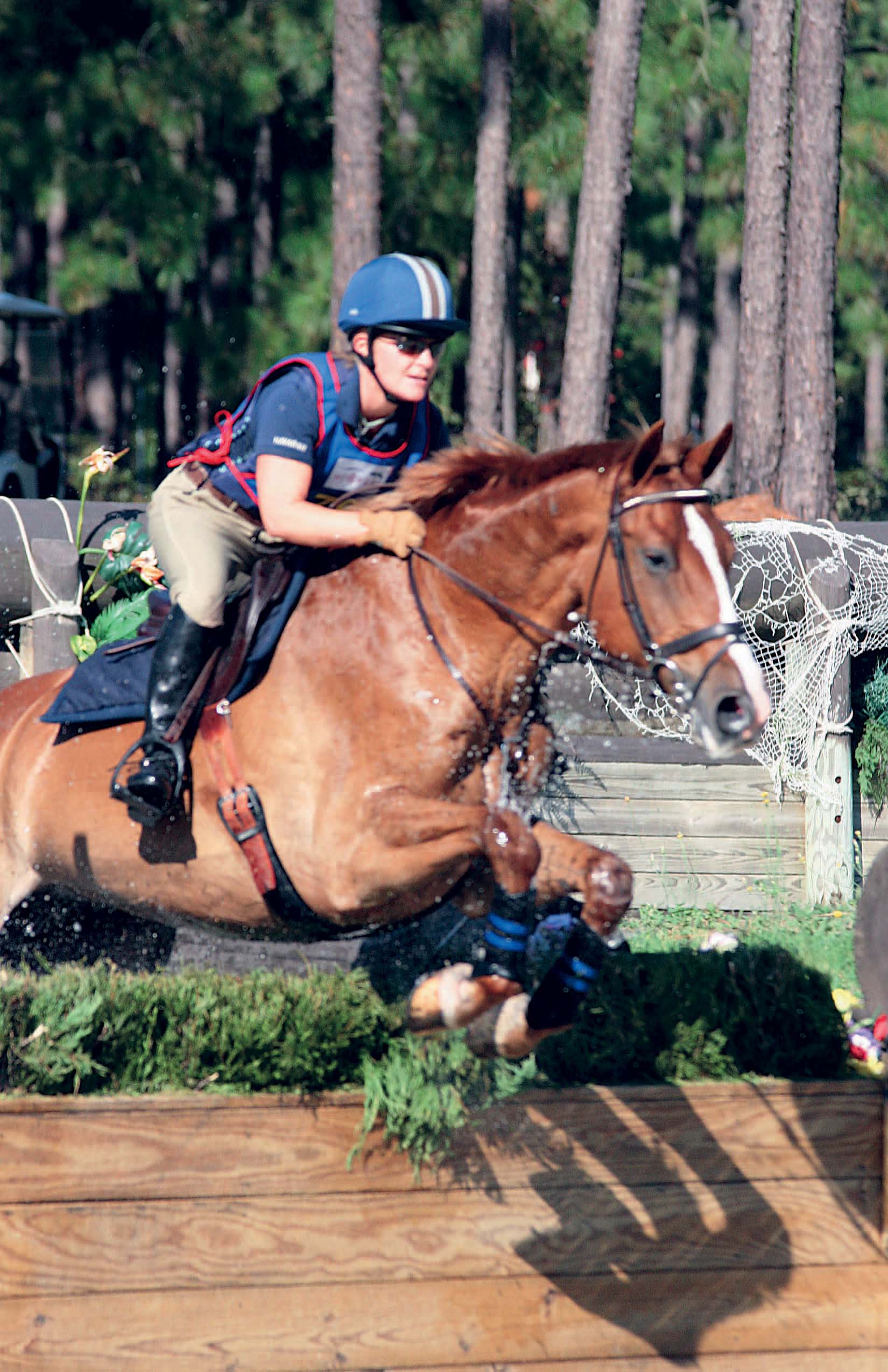


Cross-Country Jumping
Most riders take up eventing because of the cross-country phase. The thrill of speed and the excitement of tackling different fences and obstacles, along with that ever-lurking element of danger, is what draws many people to the sport. But it’s a mistake to think that riding cross-country is a free-for-all, a mad dash to gallop over fences in the proper time allowed. Cross-country riding is all about skill, endurance, strength, and nerves of steel.
Cross-Country Basics
In a good cross-country ride, both horse and rider share the same goal—to jump the fence successfully—but each has her own part to play. The rider must have a good position and balance in the saddle, the right mental reactions, and the right attitude. The horse must be forward thinking and maintain her own balance. It’s the horse’s job to jump the fence, not the rider’s. The horse must always maintain that forward enthusiasm and her own balance without always relying on the rider. The horse must learn to stay on line and not to drift.
You must have the best possible control of the horse and be in the most secure position so that when something goes wrong, you will be able to react quickly and remain safe. For cross-country, sit a fraction behind the point of balance, with the center of gravity above the stirrup, which is shortened and placed slightly more forward than usual. This places you in a “safety first” position. The stability of your leg is also very important. Your weight should press down into the stirrup; never cling with the knee, which will cause your heel to swing back. The length of stirrup means you can be clear of the saddle, which will help your horse gallop more freely. Yet when approaching and jumping the fence, your seat should be as close to the saddle as possible.
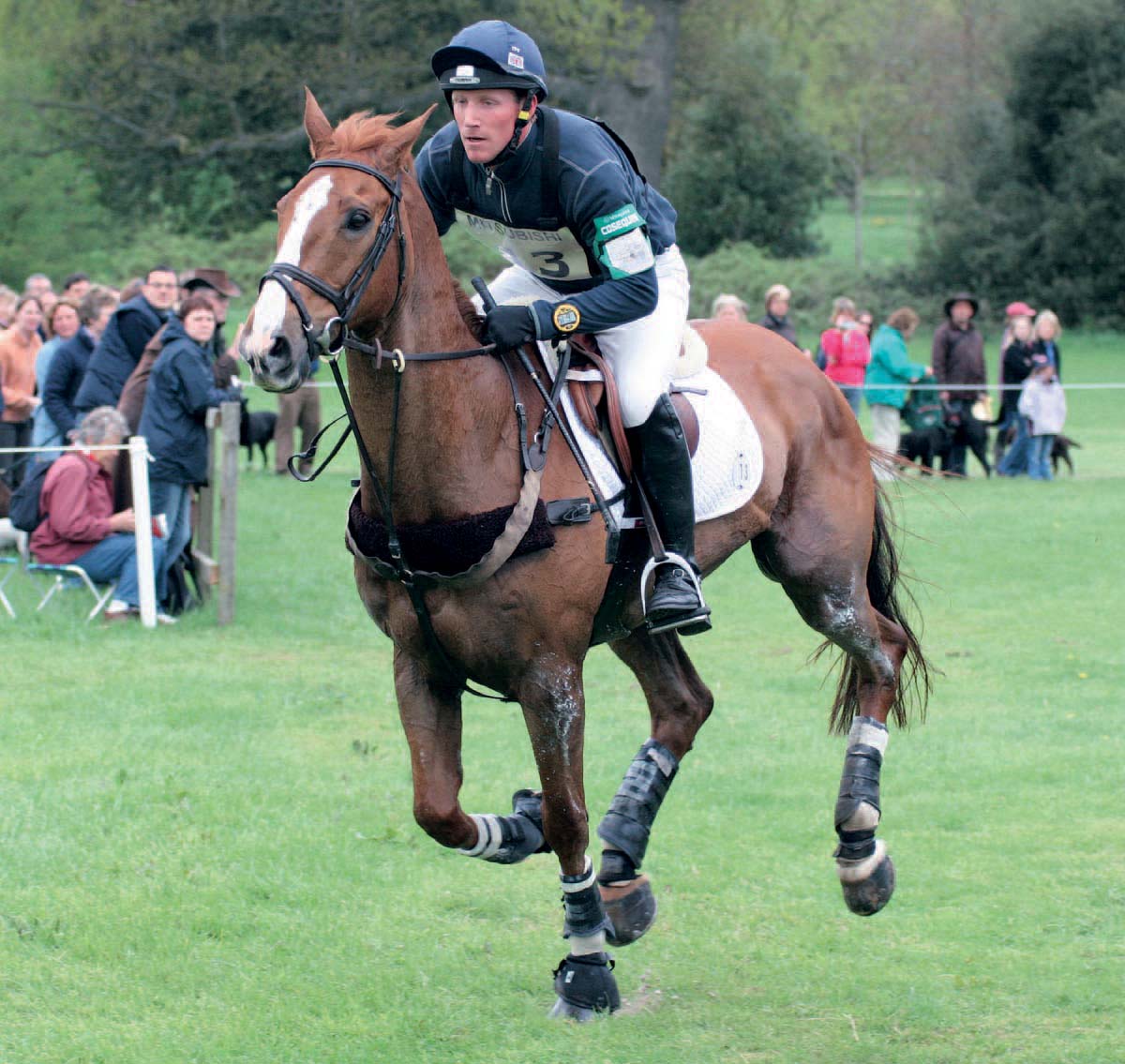
A cross-country rider maintains a good balance and position at the gallop.
The seat and lower leg position is constant, but your upper-body position will change for each type of cross-country jump. It can fluctuate between being very forward over a steeplechase fence to leaning back extremely when you jump into water with a drop on the landing side.
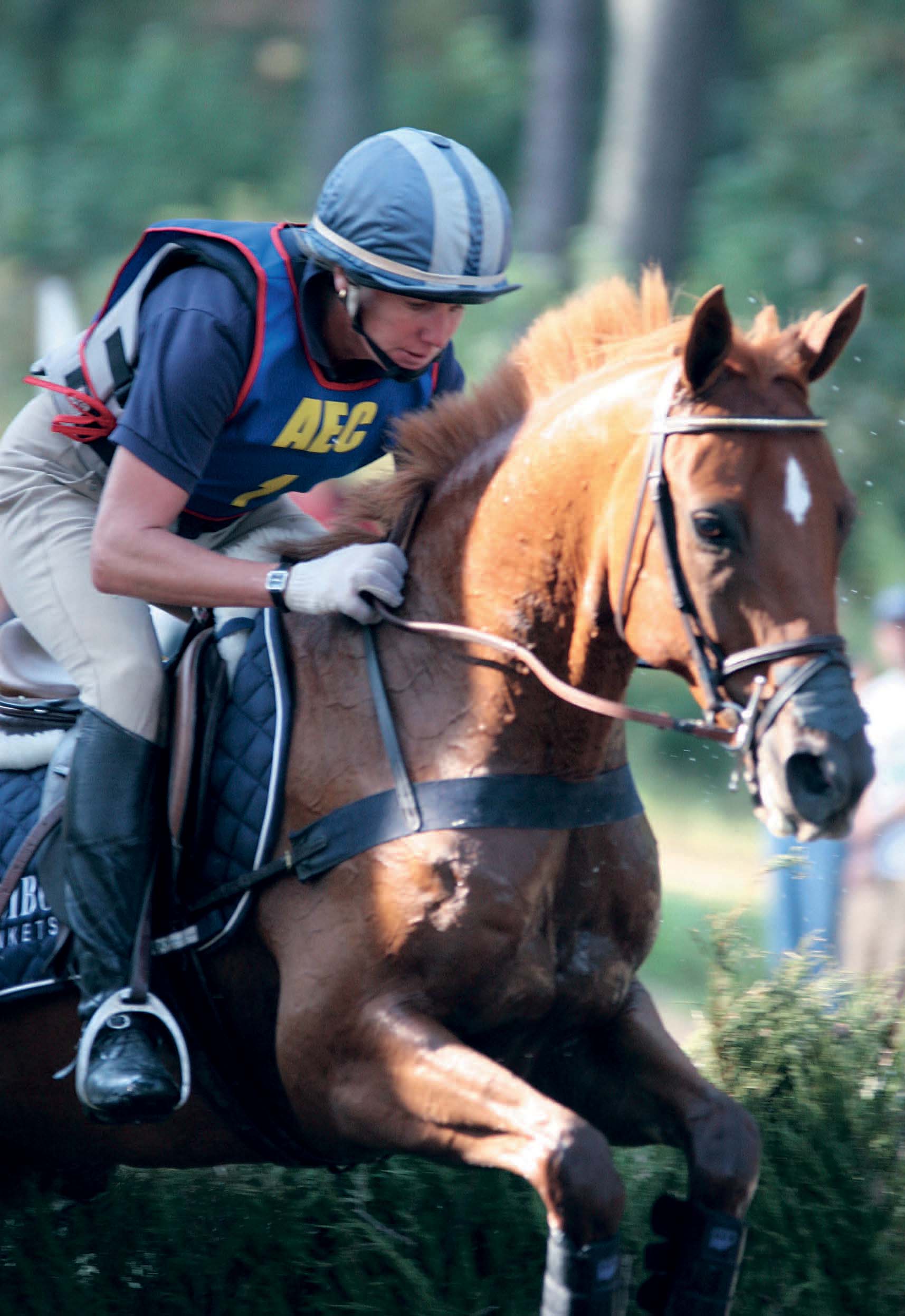
This is a good position for cross-country: the rider’s seat is close to the saddle, and her hands are in contact but are still allowing the horse freedom to jump.
Your hand should maintain a contact with the horse’s mouth, but that contact is often a challenge. Focus on keeping the connection between your hand and the horse’s mouth, but without interfering with the jump.
You also have to keep the horse on line and approach the fence in a good rhythm so that the length of the horse’s stride remains the same, whatever you have set for that fence, and at the relevant speed for that fence. It may be on a short stride for something like a rail, ditch, rail combination (also called the coffin), or it may be on a longer stride for a steeplechase fence (see chapter 3, Riding Within the Gaits). Whatever rhythm you set, try to maintain it as evenly as possible.
Cross-Country Fences
Few riders are lucky enough to have cross-country fences at home, but any rider can simulate fences. If you have a small arena or you lack cross-country jumps, you can still set up a course worthy of schooling. For small arenas, create jumps that can be ridden in several ways. These jumps will also help improve your turning and jumping at angles. For cross-country fences, you can use several of the show jumping fences, such as the water tray and the corner, and modify them to resemble cross-country courses. Coffins can be duplicated by schooling over oxers. If you have a nice stretch of field at your disposal, you can also set up permanent fences, such as a grid with a small ditch, some bounces, and a brush jump in the distance. These can be simple post-and-rail constructions.
You can use your water pan to duplicate a Trakhener fence or a ditch. You can also place the water pan on its own or in the middle of a combination. This will get you and your horse used to jumping objects without wings.
How much cross-country schooling a horse needs depends on the horse. Some horses will jump into space if pointed that way, and others are more cautious. But with good training, a horse will offer what you want as opposed to your having to hold the whole thing together.
Corners
The golden rule of jumping corners is to bisect the angle of the jump and meet that line straight without turning to jump it at the last second. The horse must maintain the line instead of taking the easy option, which is to duck out to the side, particularly if you are jumping at the extreme end of the fence. Set up a small vertical fence, and begin to jump it from different angles rather than straight on. This will teach your horse to hold her line and not run out. She must be very balanced to jump an angle, lifting both knees equally. Once your horse is very comfortable with this, add another set of standards to create the angle. Place one of the standards in front of another, almost as though you were making an oxer. Do the same on the other set, but increase the width a bit. Adding poles will create a corner. Increase the angle and height as your horse gains confidence.
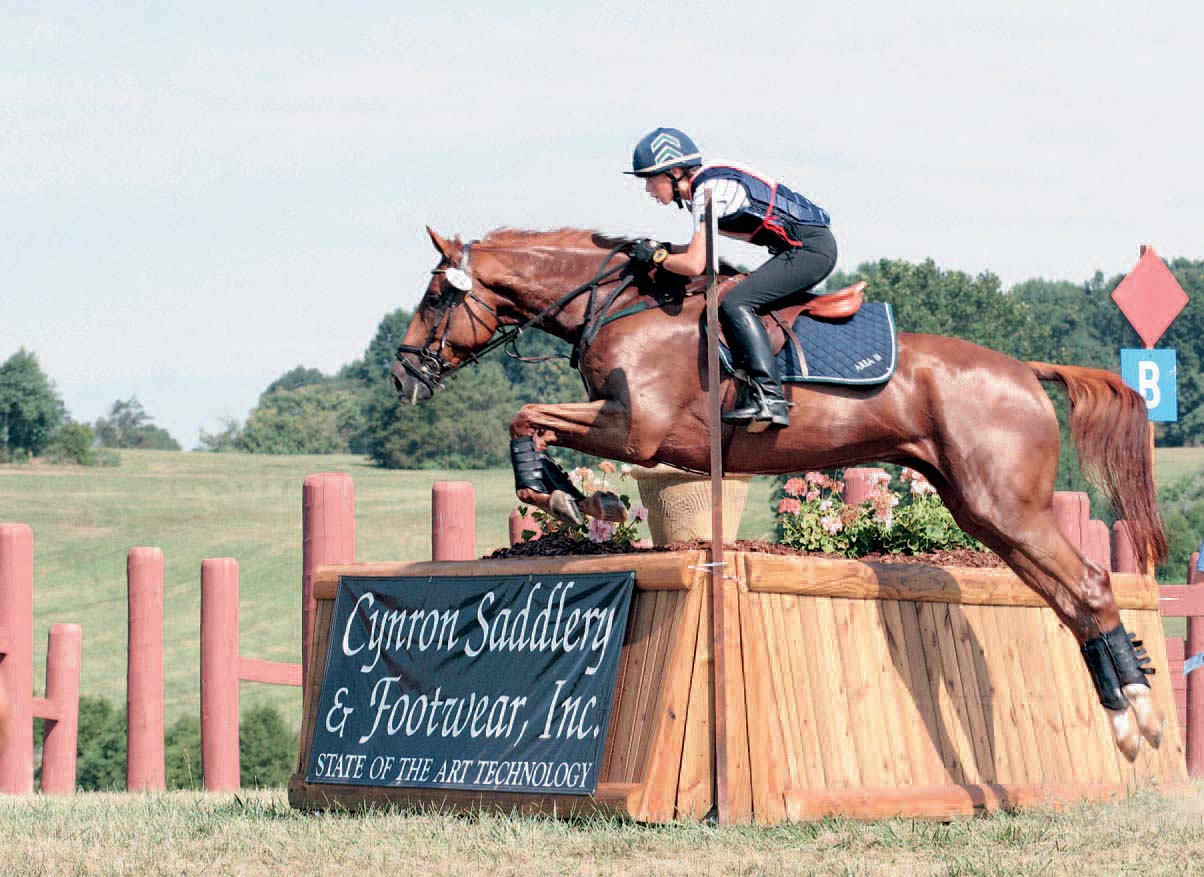
A cross-country horse and rider beautifully execute a corner jump.
If you are having problems with run-outs, say, at a right-hand corner, come to it at the left lead canter; if your horse wants to run out, she will have to change leads as well.
Ditches
Sometimes the rider is more worried about the ditch than the horse is. This is a psychological obstacle because a horse’s stride when she’s galloping is at least fifteen feet long: you’ll never find a ditch that wide. So you should say to yourself, “If a horse’s stride is that long, and a ditch is only that wide, why am I worried?” If your horse is confident about jumping holes in the ground, then don’t be worried about the width of the fence.
To jump a ditch, up the tempo, increase the length of stride, and keep coming to it. Don’t look for a stride; let the horse judge when to take off. And don’t look down into the ditch. As you approach, let the reins slip a little bit longer. Sit more upright in your position, and as you ride to the fence, ride your horse into the contact a little bit. Don’t give her a loose rein and allow her to drop her neck and look down into the ditch. On the other hand, don’t ride with the reins short and her neck short. If the horse’s neck is short, she might feel she can’t stretch her neck as she jumps, and so refuse. This advice applies to the open ditch (the ditch in front of a fence) as well as to a ditch without a fence.
The important thing to remember when jumping the rail, ditch, rail combination (coffin) is the spread you come into in the first element. Cut your speed enough to then be riding forward to the rails—there is no point in slowing down further because when the horse suddenly sees the ditch, there is a chance she will stop. Speed is not the cure! Keep an upright posture going in and through so that you are always just behind the horse, ready to react if the horse spooks at the ditch or catches a leg.
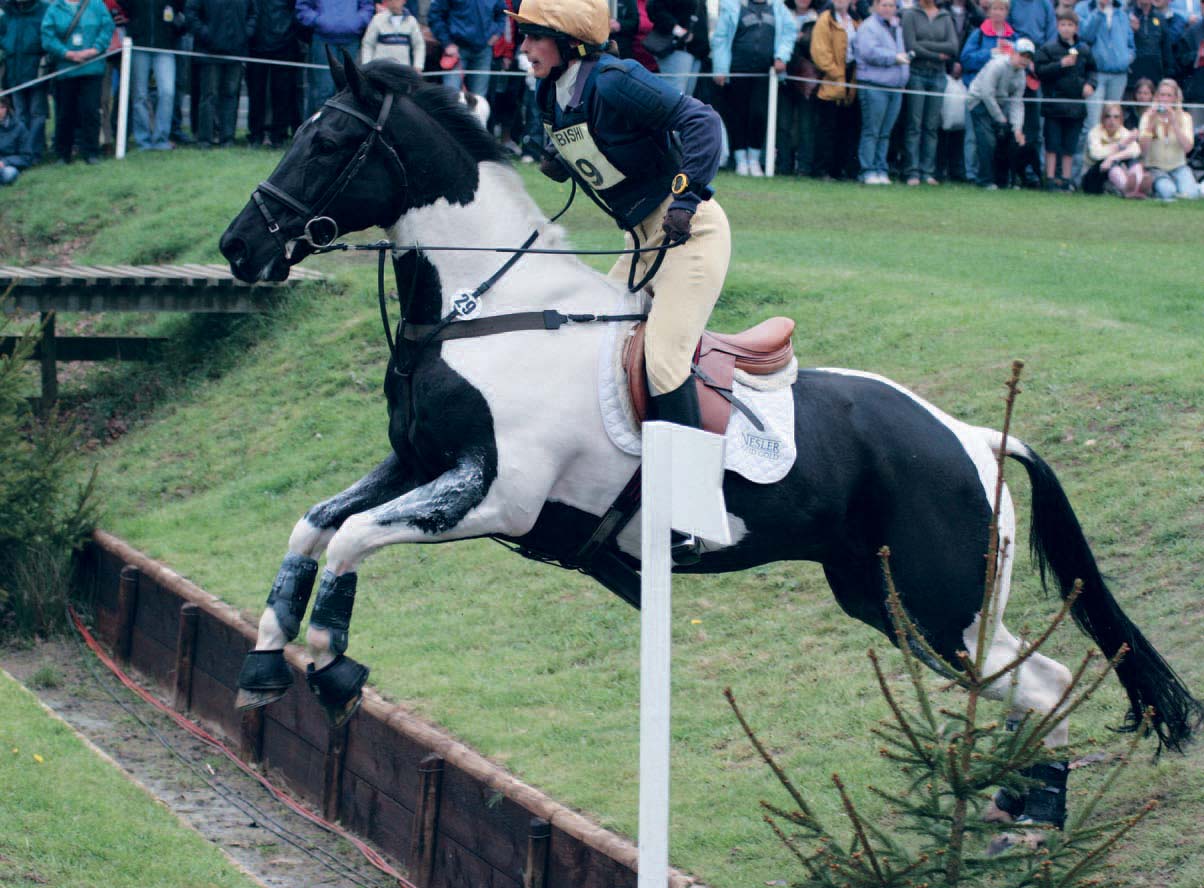
A rider maintains the upright position necessary for jumping ditches.
Water
Walk through as much water as you can—walk through puddles when it rains, and splash around in streams you encounter on your trail rides. If you have a stream on your property, walk your horse through it every day. It’s most important that your horse learn to trust that the water is not deep and that the ground underneath the water is safe; it’s not like quicksand. You shouldn’t shake a horse’s confidence in the ground; don’t take her through good ground one day and bad the next.
Walk into the water first; follow a confident horse into the water if necessary to avoid resistance from your horse. And, of course, giving lots of pats and encouragement is a must. When you’re confident that the horse will go in and out of water on her own, increase the difficulty by adding a small drop, such as a log or a small fence, that lands into the water.
Don’t school jumping out of water and up a step. There are too many things that can go wrong—your horse can miss the step and cut herself, for instance. A step is OK in competition but not in training. A step is less necessary than a drop, in any case, because all horses will jump out of water, but not all will go in.
As the jump or drop into the water gets bigger, you have to allow the horse’s neck more freedom, so ride on a longer rein. If necessary, be prepared to slip the reins through your hands over the jump.
Stay back with your upper body as your horse jumps into the water—don’t lean forward—so the horse jumps slightly away from you. Stay upright at least through the first stride in the water, then gradually take a more forward position if, for example, there is a long galloping stretch through the water. On the other hand, if it’s only one or two strides followed by another jump out of the water, stay in a more upright position all the way through the water.
Falling off is the worst thing that can happen, and the first stride after the landing is where falling usually occurs. Deep water stops the horse’s momentum, and very often the horse will stumble in the water. Modern water jumps are not very deep, so the problem is more often associated with the horse’s losing her balance as she drops into the water. Either she’s come too forward with her neck or the rider has leaned too far forward on the horse’s shoulders, causing her to lose her balance when she takes her first stride. This is why your solid cross-country position is so important.
Drops
If you hold on to your horse’s head, she will jump through your hand and jump bigger. If you are jumping a drop, loosen the rein a little bit, and keep your hand down and body back to allow the horse the freedom of her head and neck, so she just pops off the drop. Allow your horse to look down and jump down.

As her horse jumps into the water, this rider stays back with her upper body and allows the reins to slip through her hands and lengthen.
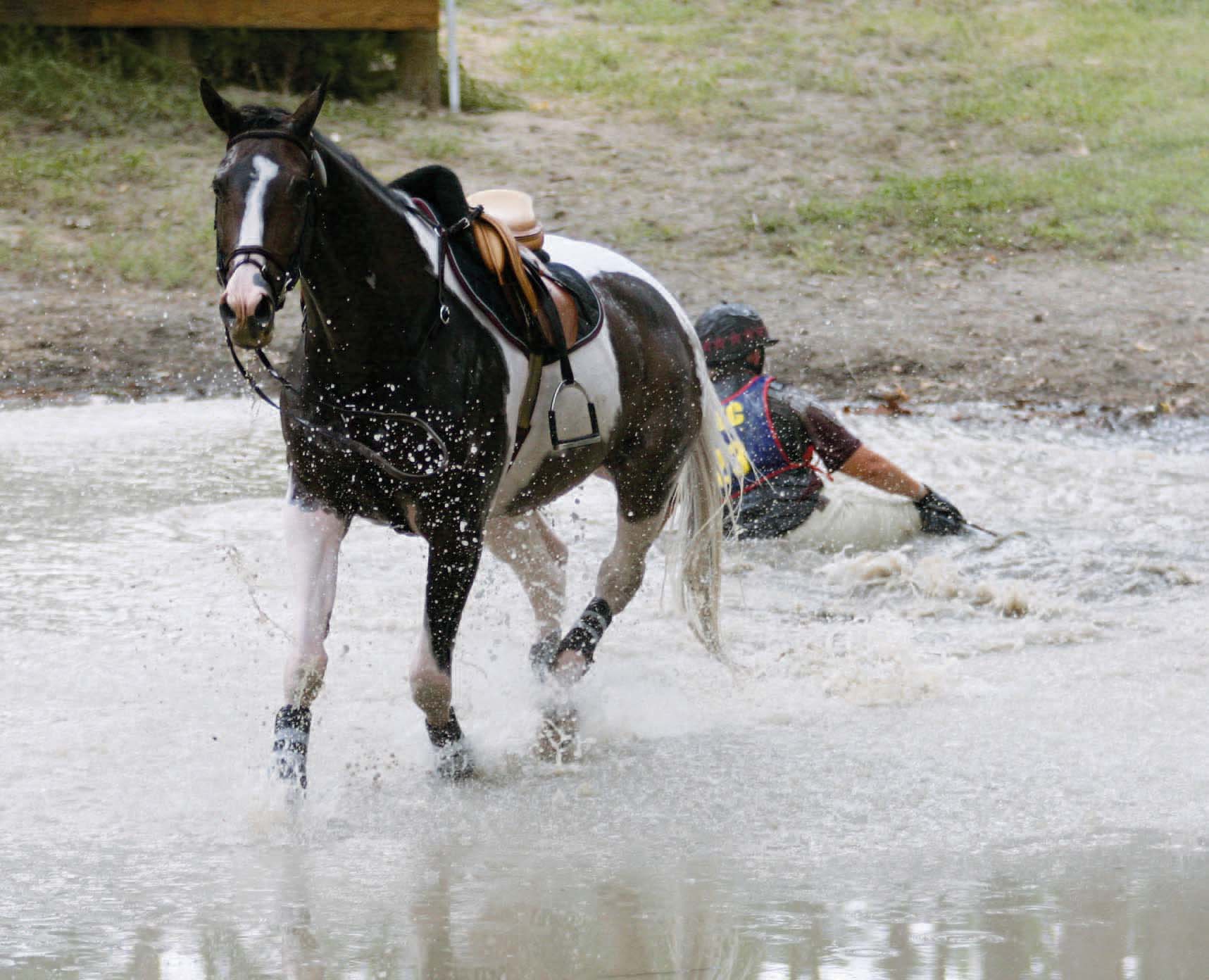
Either the rider lost position or the horse lost balance upon landing a water jump, which usually happens after the first stride in the water. Make sure your position is solid over a water jump.
Banks
Jumping up onto a bank is similar to jumping a vertical fence. Approach it on a very active forward-going stride so the horse has the energy to jump onto it. If you’re too fast, the trajectory of the jump will flatten, and your horse won’t land up; she’ll skid across the step, or she won’t land high enough. If you come in too slowly, then the horse will lose her impulsion as she jumps up onto the step, and if there is another obstacle after that, she may not have enough power to jump it.
If you are jumping a derby bank, come quite active up onto it. As you are on top of the bank, your body position should come up and back. Let the reins get longer so the horse can jump off the bank using her neck. You want your horse to jump off some banks or drops very slowly—for example, if there is a jump on the landing stride or the ground runs away on the landing side. In these cases, you want the horse to slide off the bank. So lengthen your rein and reduce the speed to the minimum—almost trot off. However, don’t hesitate at the top. Successfully jumping banks means getting that balance of speed right. Many of these situations call for good judgment: getting the right balance of speed, control, forward thought, and freedom and guiding the horse without restriction.

This rider encourages the horse to maintain an active stride while jumping onto a bank.

Cross-country fences are often unusual, such as this duck-shaped water jump. Eventers should be able to jump anything!
Cross-country is really a confidence test between horse and rider—have faith in your horse, and the horse will have faith in you. Don’t forget that you are a team and that you should try to work together. When you ride cross-country and your horse sees a fence that she has never encountered before, she’ll look to you for help. If you are riding confidently, holding the contact and using your leg, you’ll tell her all is well. Even though you might be scared inside, ride confidently.